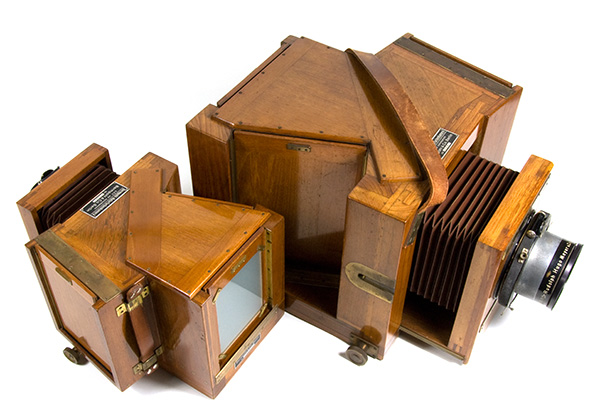
9x12cm and 13x18cm Bermpohl Naturfarbenkameras

Pictured above are two one-shot three-color cameras made by Bermpohl & Company of Berlin, Germany. Bermpohl Naturfarbenkameras were manufactured from 1929. Camera production halted during World War II but manufacture resumed after the war. The two cameras pictured on this page date to the 1930s. Another of my Bermpohl cameras has a Schneider Xenar lens dating to 1949-50. That camera was purchased new in post-war Germany by an American photojournalist. Bermpohl one-shot camera manufacturing ended in the mid-1950s
Naturfarbenkamera translates to natural color camera in English. The one-shot Bermpohl was in its day, considered to be one of the finest color cameras available. The Bermpohl is a color separation camera, often simply called a color camera. Briefly, the reason why a variety of color separation cameras were invented and used, was that until the 1950s, there wasn't a commercially viable alternative method of producing high quality color photographs for reproduction in printed media or for exhibition. The color separation camera played its part in the process but didn't in itself produce a color image. The negatives it created were further manipulated by any one of a variety of assembly methods, either photographic or photo-mechanical, to produce the final color print.
Color separation cameras record three images of a subject on three separate black and white plates or films. One photograph is made through a red colored filter, another through a green filter and the third through blue. The three photographs are processed as normal black and white images which in fact they are; however, each has only recorded one-third of the spectrum, so they don't look like full-scale black and white negatives. The negatives were used to make high quality color prints via a variety of photographic methods including Trichrome Carbro, Jos-Pe, Pinatype, Eastman Wash-Off Relief, Defender Chromatone, Kodak Dye Transfer and Curtis Orthotone and Permatone. For publication purposes, mechanical printing processes were used. To this day Trichrome Carbro is reputed to have produced the finest and most permanent color prints of any photographic process.
The main driver of sales of the color separation camera was a growing demand for color images in all forms of advertising, particularly within the United States. The era of the commercial color separation camera spanned at most three decades: from ca 1925 to the mid-1950s. Cameras were available before and after these dates, but not in the same numbers. In Victor Keppler's 1938 book on color photography titled The Eighth Art, the author wrote, "A strange development - and one worthy of note - is that nearly 80 percent of the entire output of three-color one-shot cameras manufactured by Bermpohl were sold to the United States. Another 15 percent were delivered to other countries, while only 5 percent remained in Germany."
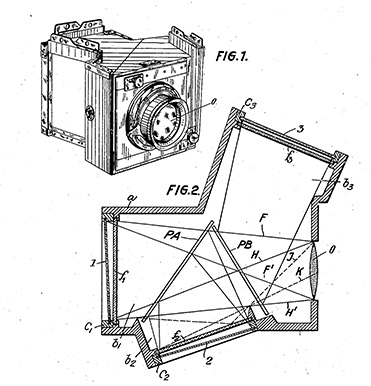
Internally, the Bermpohl directs light from the lens in three directions, exposing three separate photographic plates simultaneously. Two semi-transparent mirrors are positioned behind the lens. A fraction of the light is reflected to one side by the first semi-transparent mirror. The remaining image light passes through the first mirror where it is intercepted by a second semi-transparent mirror. This mirror, positioned at a suitable angle, reflects a portion of the light to a second photographic plate located on the opposite side of the camera body. The remaining light that was not reflected by the second mirror passes through that mirror to expose the plate at the back of the camera.
It would be convenient to say that the image light is divided into thirds, however this is not the case. Each of the three photographic plates requires a different exposure because even panchromatic emulsions are not equally sensitive to red, green and blue light. A set of separations is said to be balanced when the density of a neutral gray, white or black in each of the three negatives is equal.
The patent for the Optikotechna Spektaretta tri-color camera describes a typical method that camera manufacturers used to balance the three exposures, i.e., by varying the light reflection/transmission ratios of the reflectors.
Bermpohl cameras have a wood body made entirely of teak. Teak is very stable and it is the best wood to use in a camera where precise alignment of multiple mirrors and focal planes is necessary. A quality three-color camera must maintain its alignment over time and through varied climactic conditions. An additional benefit of teak is it is very beautiful, especially when worked by a master craftsman, as was Wilhelm Bermpohl.
Bermpohl cameras are heavy. None of the models can be used handheld. They require a strong, stable tripod or stand. The 9x12cm camera weighs approximately 12 pounds; the 13x18cm camera weighs about 28 pounds. Mount three loaded glass plate holders and the cameras will put on a few extra pounds. Bermpohl also made an 18x24cm model. I have yet to see one in person and I wonder if I'd be able to lift it when I do.
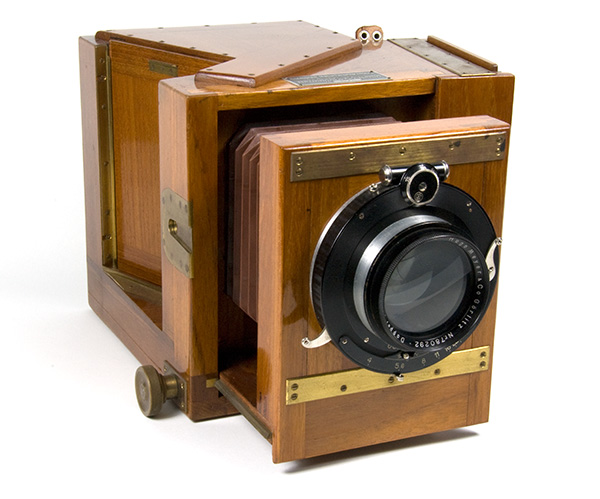
The 9x12cm Bermpohl model made photographs on 9x12cm photographic glass plates. Glass plates are a thing of the past, nearly extinct, but they continue to be used in a few specialized fields. Few people nowadays know what they are. Photographic glass plates are flat sheets of glass coated with photographic emulsion. They serve the same function as the flexible film available today, but the supporting material is glass rather than polyester or acetate. A 9x12cm image measures approximately 3 1/2 x 4 3/4 inches.
This camera is fitted with a Hugo Meyer & Co. Gorlitz Doppel Plasmat 21.5cm f4 lens. The shutter is an F. Deckel Compound with speeds from 1 to 1/75 second. The lens is superb and of course, fully color corrected. Bermpohl considered the 9x12cm size to be suitable for color portraits and a good choice for outdoor work because it was their lightest model.
A Bermpohl sales brochure, ca. 1940, lists the price of a 9x12cm model as 1,450 Reichsmark.
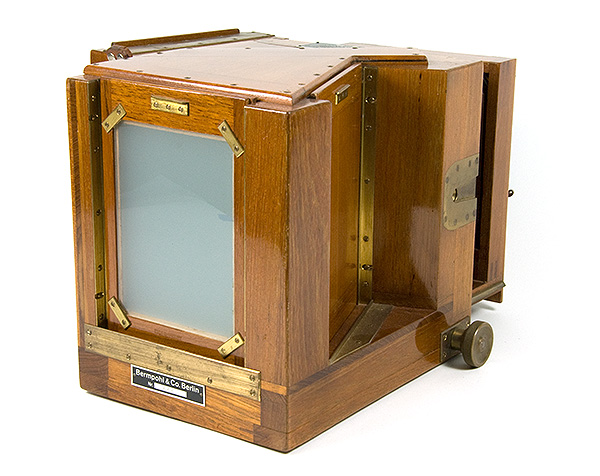
The subject is composed and focused on a ground glass screen. The 9x12cm Bermpohl could be ordered with a permanently attached top-mount reflex viewfinder. Of all the Bermpohl one-shot cameras I've seen over the years, most do not have the external viewfinder.
The horseshoe-shaped brass plate that can be seen in the photo above is a heavy-duty tripod mount. Both the 9x12 and 13x18cm cameras have extra strong horizontal and vertical tripod mounts. When plate holders aren't attached to the camera, it is important to cover the camera openings to protect the colored filters and keep the interior free of dust. The back opening is protected by the removable ground glass panel and the two side openings are protected by wooden panels supplied with each camera.
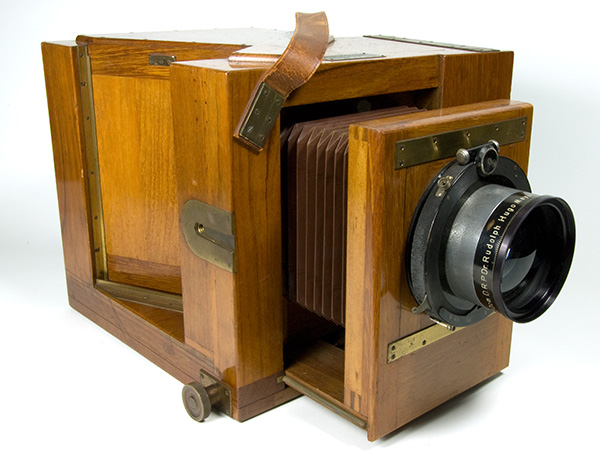
The mid-sized Bermpohl takes photographs on 13x18cm (5x7 inch) glass plates. As mentioned above, this is a heavy camera, weighing in at around 28 pounds with lens and without plate holders. Bermpohl recommended this size for color advertising and illustration photography. The 13x18cm plates require less enlargement than 9x12cm plates, so print quality should be better using the larger camera. The large 18x24cm (7 x 9.5 inch) model was Bermpohl's recommended size if the images were to be used without enlargement.
The lens on this camera is a Dr. Rudolph Hugo Meyer Doppel Plasmat 30cm f4. The shutter is an F. Deckel Compound with speeds from 1 to 1/75 second. As on the 9x12cm model, this lens is of very high quality. Both lenses are quite fast considering their focal lengths and degree of optical correction. Bermpohl's selection of first-rate lenses is one reason why their cameras were very expensive. Because color cameras divide the image light three ways, and due to losses imposed by glass mirrors and colored filters, color cameras can be quite slow. Exposure times were often as long as one second.
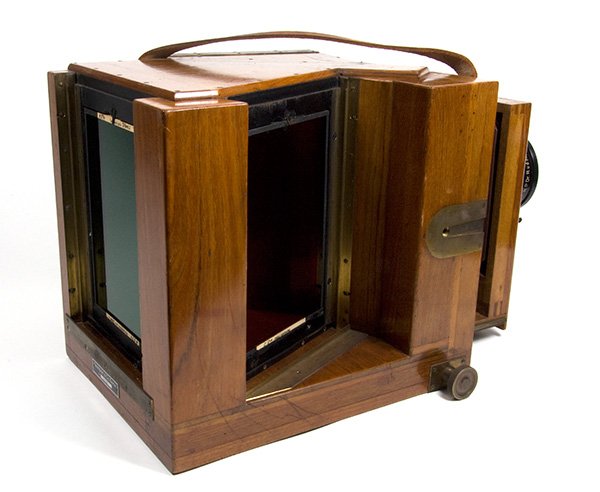
The photo above shows the camera with the ground glass panel and a cover plate removed. The green and red filters can be seen in the body openings. The next step in using the camera would be to insert plate holders. The filters were made to be removable and one reason for this is there are two pairs of red and blue filters. The color values differ between the pairs. One pair is used when shooting in daylight, the other is for artificial light. The green filter serves double duty and can be used with either light source.
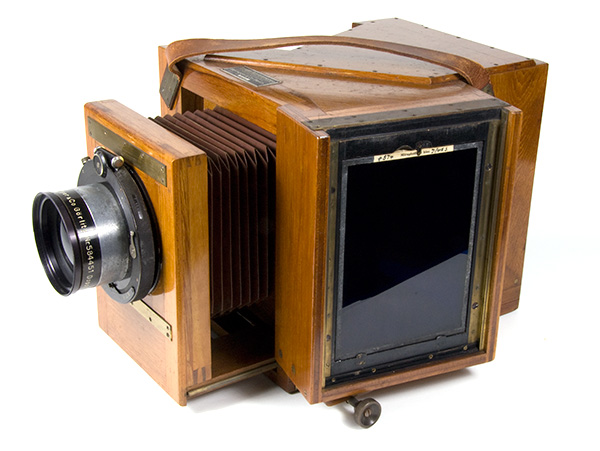
The photo above shows the Bermpohl camera with a blue filter in place. The blue filter is nearly twice as thick as the green. My approximate measurements of the filter thicknesses are: green - 4mm, red - 5mm and blue - 7mm. There is no difference in thickness between the daylight and artificial light pairs. The filters are different thicknesses because the lengths of the light paths through the camera must be equal. If they are not, the three images will not be the same size on each plate. For each path, the light must travel the same distance in air and glass. Image light traveling to the green filter passes through two mirrors; light traveling to the red filter passes through one mirror and light on the blue path does not pass through a mirror; it is only reflected. In addition, there are clear sheets of optically-flat glass inside the camera body, in front of the red and blue filters.
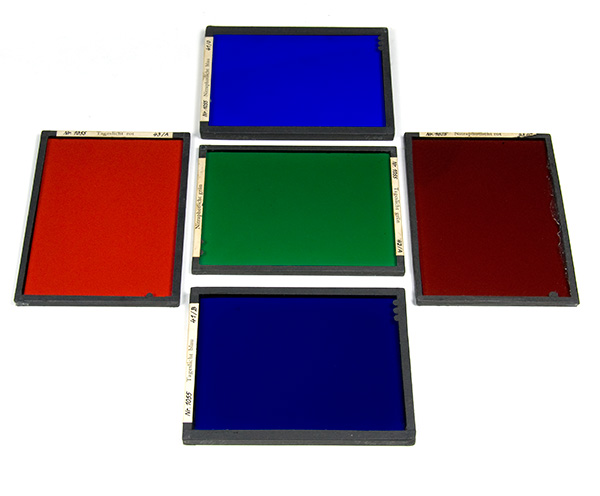
Above is a set of five Bermpohl color filters. Included in a set are two reds, two blues and one green. Under artificial light, the red and blue filters labeled nitraphotlicht are to be used. There is also a pair of red and blue filters labeled tageslicht. That pair is used when shooting in daylight. The green filter carries two labels: nitraphotlicht and tageslicht, indicating it is to be used in either type of light.
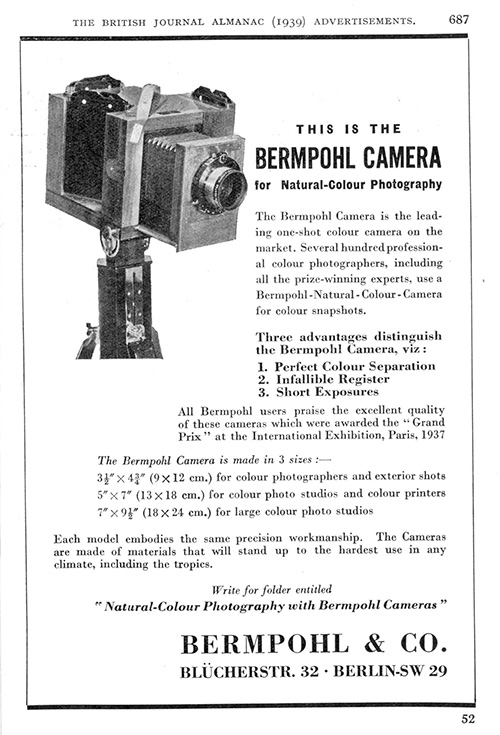
Related Information

|
Page created December 28, 2009; updated July 5, 2022
|